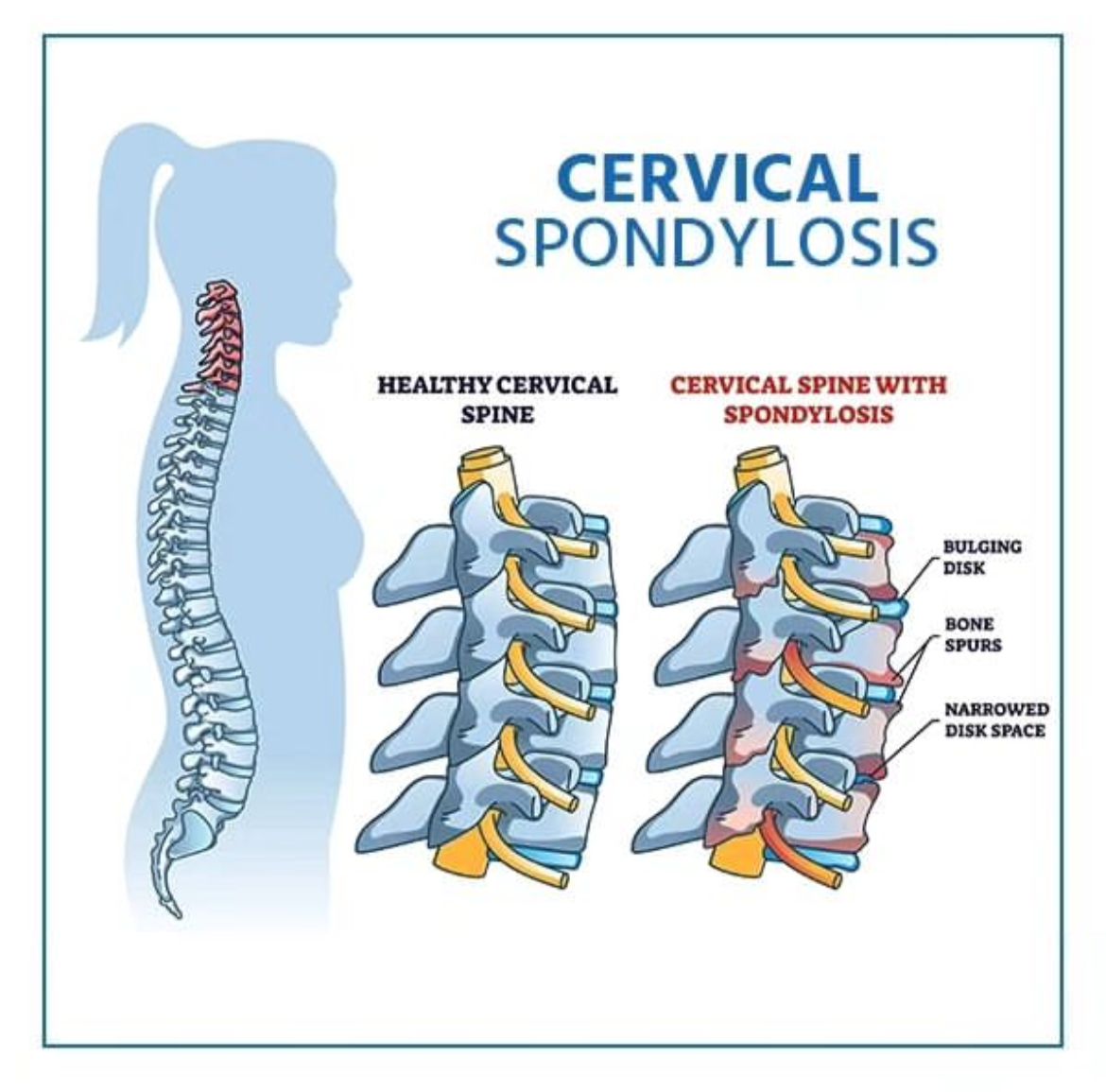Introduction
Cervical spondylosis is a common age-related condition that affects the joints and discs in your neck. While many people with cervical spondylosis may experience mild discomfort, certain activities can exacerbate symptoms, making the pain more intense. If you’ve been diagnosed with cervical spondylosis or are suffering from neck pain, avoiding these four things can help reduce stress on your neck and prevent further injury.
1. Work-Related Activities That Put Extra Stress on Your Neck
Many daily tasks, especially those related to office work, can cause neck strain. Activities like prolonged computer use or constant phone calls can make the neck muscles stiff, leading to discomfort or worsening of symptoms.
What to Avoid:
- Sitting at a desk for long hours without a break.
- Poor posture while working (e.g., slouching).
Tip: Ensure your workspace is ergonomic. Take regular breaks to stretch and move around to avoid prolonged stress on your neck.
2. High-Power, Heavy Lifting Exercises
Engaging in heavy lifting or strenuous physical activities can strain your neck muscles and worsen spondylosis. Exercises that involve weightlifting, especially over the head, can put unnecessary pressure on the spine, aggravating the condition.
What to Avoid:
- Heavy lifting without proper form.
- Intense gym workouts that stress the neck.
Tip: Stick to light exercises and consult a physiotherapist for neck-friendly workouts that can help strengthen muscles without causing harm.
3. Long-Distance Travelling
Traveling long distances, especially by car or plane, can lead to neck stiffness and discomfort due to prolonged sitting in awkward positions. Lack of mobility and support during long journeys may aggravate your cervical spondylosis.
What to Avoid:
- Long trips without frequent breaks.
- Sitting in cramped spaces without neck support.
Tip: Use a supportive neck pillow during travel, and be sure to take short breaks to walk around and stretch your neck whenever possible.
4. Twisting Your Body or Neck Abruptly
Sudden movements or twisting your body quickly can strain your neck muscles and exacerbate symptoms of cervical spondylosis. Abrupt twists can put your neck at risk, leading to muscle injury or worsening of existing pain.
What to Avoid:
- Quick, jerky movements of the neck.
- Twisting your body without proper posture.
Tip: Move carefully and maintain good posture. When turning your body, ensure your neck remains stable to avoid sudden twisting.
Myths and Facts About Physiotherapy for Arthritis
| Myth | Fact |
|---|---|
| Myth 1: You have to rest completely when you have arthritis. | Fact: While rest is essential to avoid overexertion, complete immobility can do more harm than good. Resting for prolonged periods can cause muscles to weaken, leading to increased joint stiffness and discomfort. Maintaining an active lifestyle with the right exercises is crucial. Physiotherapy focuses on gentle movements to keep the cartilage healthy, improve flexibility, and reduce pain without aggravating the condition. It is all about balance—rest when needed, but don’t stay inactive. |
| Myth 2: Exercise will worsen arthritis symptoms. | Fact: Properly guided exercise is one of the best ways to manage arthritis. It strengthens the muscles around the joints, providing better support and reducing strain. This, in turn, helps in alleviating symptoms and improving joint mobility. Physiotherapists create personalized exercise routines that are low-impact and tailored to your condition, focusing on pain relief and gradual muscle strengthening. |
| Myth 3: Physiotherapy is only for people with severe arthritis. | Fact: Physiotherapy benefits anyone with arthritis, regardless of the severity. In fact, early intervention with physiotherapy can help prevent the condition from worsening. Even if your arthritis is mild, regular sessions can help you maintain joint function, manage pain, and slow down the progression of the disease. The sooner you start, the better the outcomes. |
| Myth 4: Physiotherapy is painful and uncomfortable for arthritis patients. | Fact: Physiotherapy is designed to ease discomfort, not increase it. A qualified physiotherapist will ensure that exercises are gentle and suited to your pain tolerance. If a movement is too painful, they will adjust the routine to make it more comfortable. The goal is to enhance joint mobility and reduce pain in a controlled, professional manner, helping you feel better without unnecessary strain. |
| Myth 5: Arthritis only affects older people, so younger individuals don’t need physiotherapy. | Fact: Arthritis can affect individuals of any age, including young people. Conditions like rheumatoid arthritis and juvenile arthritis can develop early in life. Physiotherapy can be an important part of managing arthritis at any age, helping to maintain joint health, reduce pain, and prevent further complications, regardless of when the symptoms appear. |
Detailed Explanation of Myths and Facts
Arthritis Affects All Ages:
Arthritis isn’t limited to older adults. Rheumatoid arthritis and juvenile arthritis can affect younger people too. Regardless of age, physiotherapy helps maintain flexibility, strengthens muscles, and relieves pain, allowing people of all ages to manage arthritis effectively.
Rest vs. Mobility:
Many people believe that resting as much as possible is the best way to manage arthritis, but immobility can make the situation worse. The key is to find a balance between rest and controlled movement. Physiotherapists design exercise plans that help you stay active without overexerting your joints, ensuring that your cartilage stays healthy and your muscles don’t weaken.
Exercise as a Friend, Not a Foe:
There’s a misconception that exercise will worsen arthritis pain, but in reality, regular, gentle exercise can alleviate symptoms. Strengthening muscles around the joints reduces pressure on the affected areas, which helps in managing pain and improving mobility. The right kind of exercises, such as low-impact activities like swimming or stretching, are beneficial and can even slow down the progression of arthritis.
Physiotherapy for All Stages of Arthritis:
Whether you’re in the early stages of arthritis or dealing with advanced symptoms, physiotherapy can offer relief. It’s not reserved for severe cases. Early intervention can prevent deterioration of the joints and help maintain function. This makes physiotherapy valuable for anyone experiencing arthritis, no matter the stage.
Comfortable and Tailored Care:
Many patients fear that physiotherapy will involve painful exercises, but this is a myth. Physiotherapy is about making the patient comfortable and reducing pain. A skilled physiotherapist will adjust exercises to fit your comfort level, focusing on long-term relief and functional improvement without causing more pain.
Conclusion
Cervical spondylosis can be challenging, but with the right lifestyle adjustments, you can manage your symptoms and improve your quality of life. Avoiding certain activities and following the advice of a physiotherapist can help protect your neck from further injury and relieve pain. At Sneha Physio, we specialize in neck pain management, helping you stay active and pain-free.
For more tips on neck health and pain management, visit our Posture Correction and Chiropractic Therapy pages for expert guidance




